Frida Kahlo’s fashion evolution is a lesson in messy feminism, deep love, and enduring pain
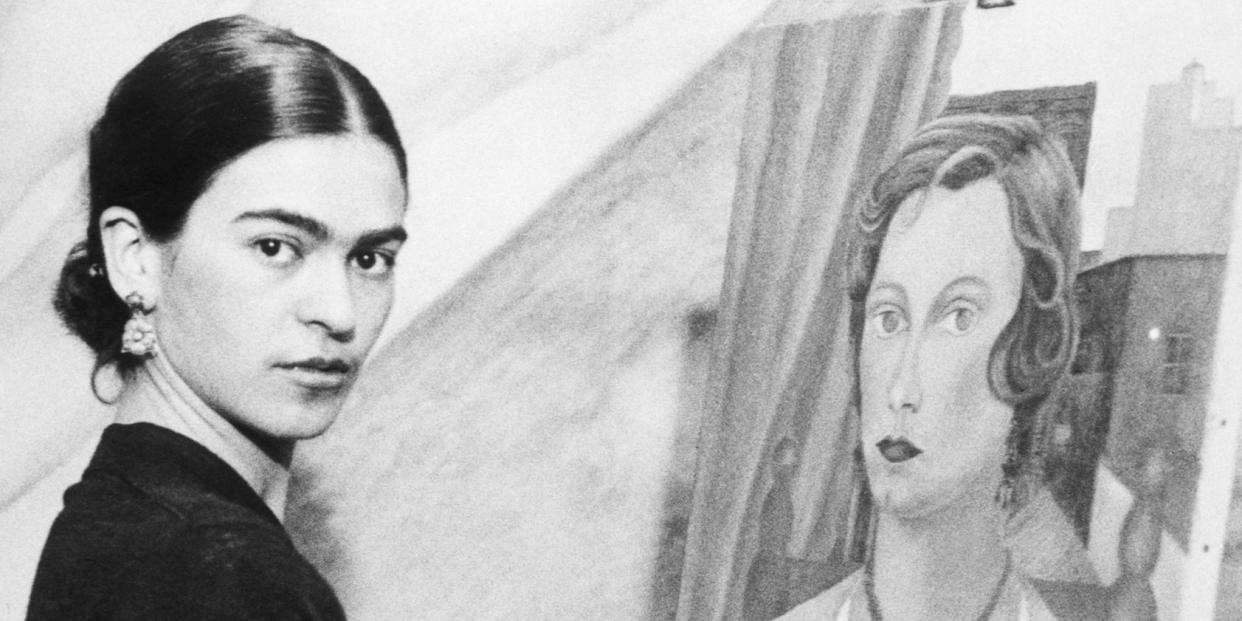
Frida Kahlo; the surrealist Mexican painter, the master of the self-portrait, the fashion rebel, the feminist icon, the wife of Diego Rivera. It has all been said already, and yet, if there’s one thing to learn from Carla Gutiérrez’s new illustrated documentary film, Frida, it’s that Frida, the person, was just a normal, passionate, complex woman; and that’s the whole point.
“In a film, you only have 90 minutes to tell a whole life. Our movie is really about a woman who could not contain her voice or herself, and I think that’s shown in her paintings, but also in the way that she portrayed herself to the outside world,” says Gutiérrez, a film editor whose two decades of credits include 2018’s RBG and 2021’s Julia Child documentary Julia.
The film—premiering at the annual Sundance Film Festival in Park City, Utah—tells Frida Kahlo’s life story through her own writings, recovered from a damp, abandoned bathroom in her and Rivera’s old home, la Casa Azul, in Mexico City.
The letters and diary entries reveal the depth of Frida’s layered personalities and deeply human tendency to change herself—how she looked, what she created—in reaction to her experiences. With each stage of her life came a different era of fashion. As a young, rebellious student, she favoured tailored suits and accented her masculine features, which she thought of as sexy. When she was with Diego, she became a traditional Tehuana woman, in sophisticated, colourful dresses and bright floral headpieces. And in her final years, when the pain of her ailments became too much, she wore her suffering, hand-painting her medical corsets and prosthetic legs to make them beautiful.
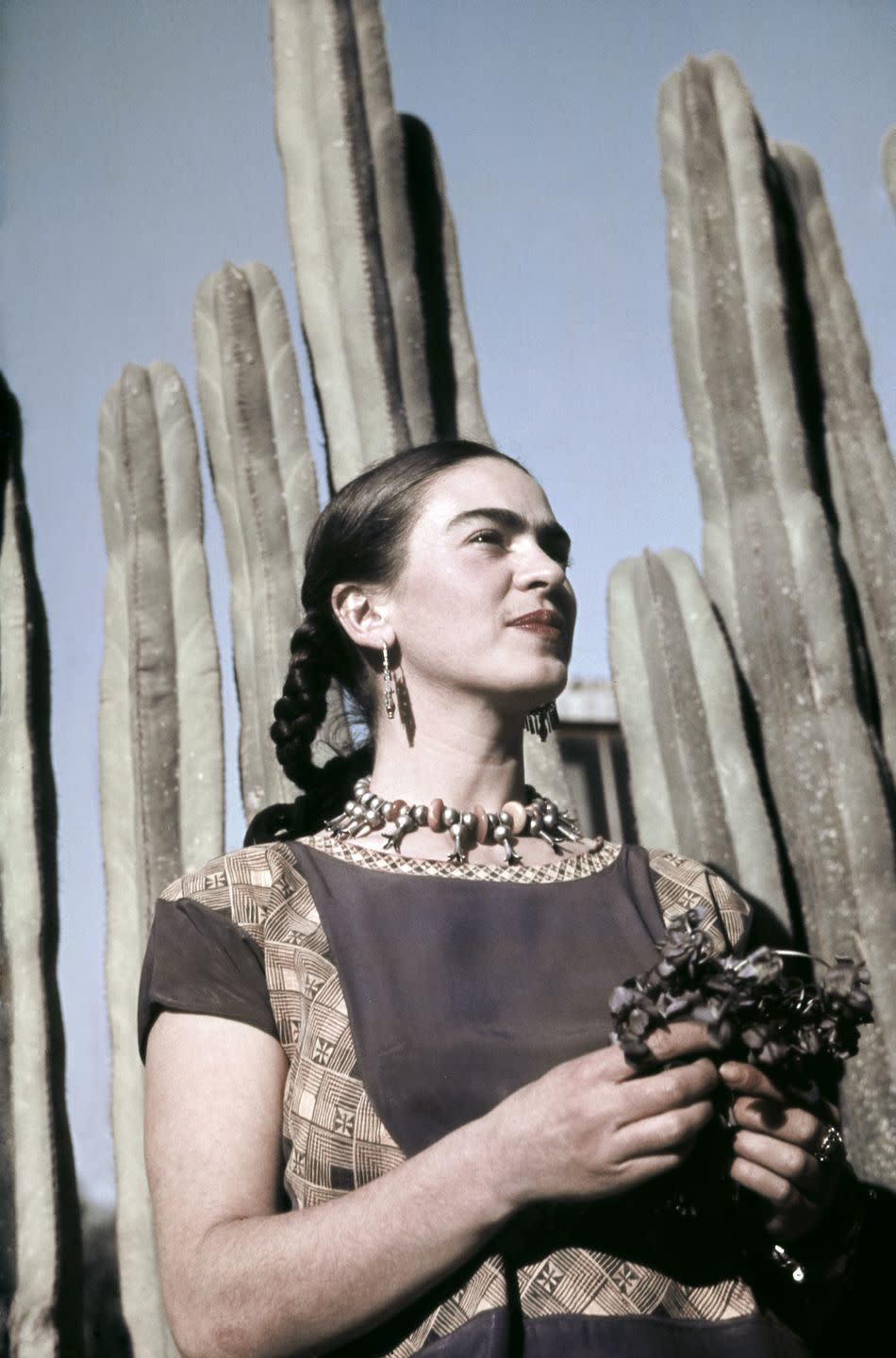
A young rebel
Frida’s teenage years fell near the end of the Mexican Revolution, a period of ardent nonconformism in the country, and turmoil followed by enlightenment—her look showed that. In college, she befriended a group of rebellious young men who called themselves Los Cachuchas, or “the Guys With the Hats.” She dressed like them, in loose, tailored suits, crisp white shirts, skinny ties, buffed leather shoes, and newsboy caps. She was one of the boys—except that she was also attracted to the boys, and wanted to be them as much as she wanted to sleep with them. Tomboy stuff.
“She was a rebel and a badass back then, and she would have been a rebel and a badass now.”
At the time, a fresh-faced Frida wore no makeup and often slicked her hair back to accentuate her striking masculine features: her sharp jaw, her dark eyes (which seemed to be permanently, naturally outlined), her strong brows, the dark hair on her upper lip. These physical characteristics were not considered obviously beautiful in the 1920s, when round faces and curly flapper bobs were the ideal—but Frida was confident in her skin, and through the years, her jet-black facial hair appeared, without fail, in her self-portraits.
“She looked so good when she was bending gender norms; she just felt really comfortable with that,” Gutiérrez says. “She was a rebel and a badass back then, and she would have been a rebel and a badass now.”
One famous photo, taken in 1926 by Frida’s father, German-Mexican photographer Guillermo Kahlo, shows Frida wearing a full menswear look while standing with her mother, Matilde, sister Cristina, and other family members. While the women around her are in breezy flapper dresses, strands of pearls, and romantic, short hairdos, Frida is in a three-piece grey suit composed of a blazer and a fitted vest layered over a white collared shirt accented with a tie, plus slouchy high-waisted trousers and a pocket square. She has her hair in a slicked-back, side-parted bun and holds a cane, as she often did after a run-in with polio at a young age left her with one leg shorter and thinner than the other.
That all changed when she met Diego Rivera.
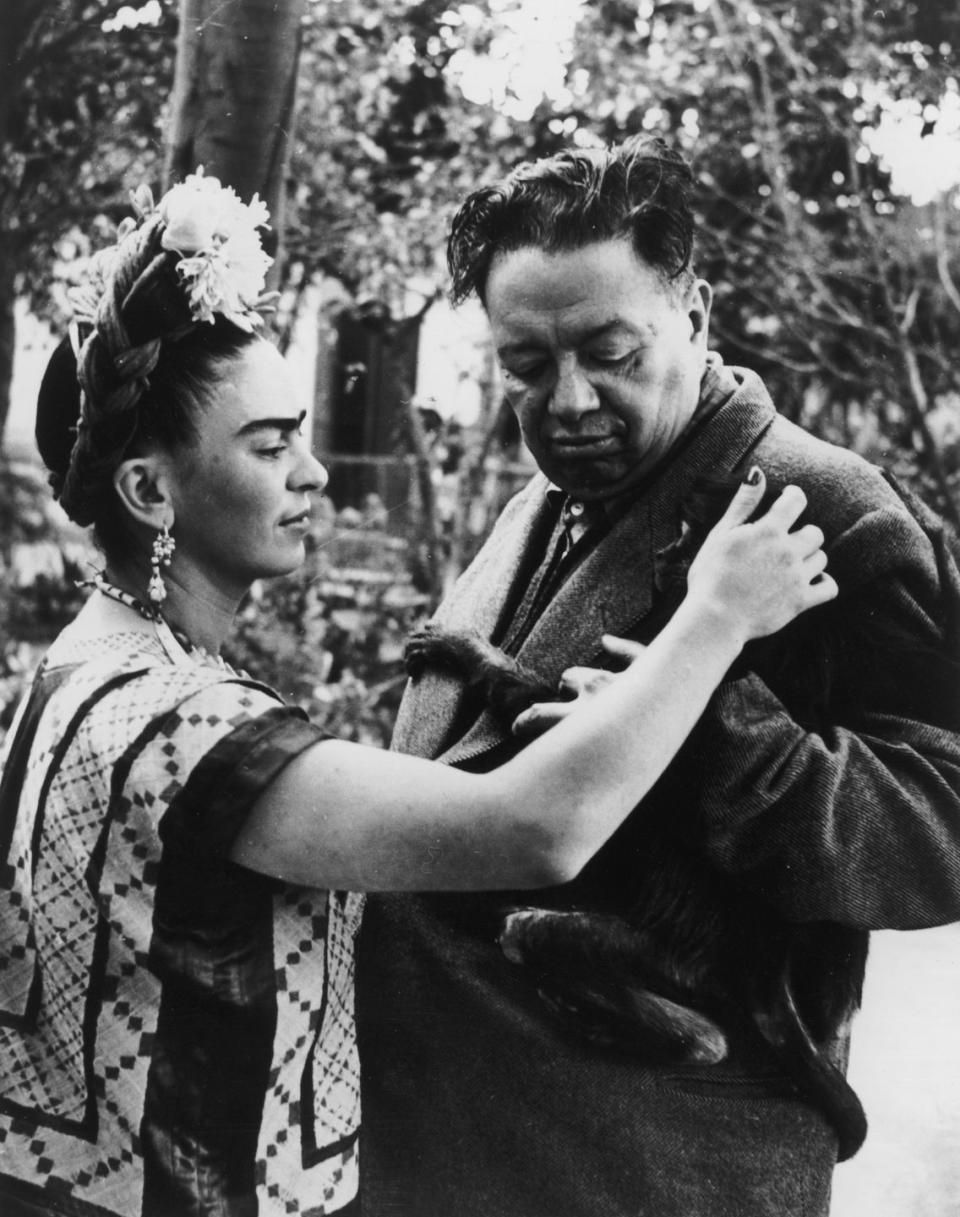
Her lovestruck Tehuana era
Independent and strong as she was, Frida’s fashion was at its most romantic when she was with Diego—the love of her life.
Because he was a communist muralist at the peak of political activism in Mexico, Diego loved showing his patriotism—and Frida loved pleasing him. So began her era of traditional Tehuana dresses. The typical dresses of the women of the isthmus of Tehuantepec, in the southern Mexican state of Oaxaca, are known for their intricate floral embroideries, ample layered skirts, and vibrant colours. They embody grace, elegance, and national pride.
“It was the bohemian, artistic, very nationalistic movement that was happening coming out of the revolution—looking at the indigenous origins with a lot of pride and wanting to claim that again. But Frida took it to a whole new level,” Gutiérrez says.
When she wasn’t in a dress, Frida wore artisanal Mexican blouses tucked into traditional skirts, often styled with handmade shawls, fresh floral headpieces adorning her elaborate braided hairdos, big jewellery (including gold chandelier earrings and beaded necklaces—which she sometimes made herself), and bold red lipstick. Her nails, too, were painted in bright colours to match.
“She took these traditional looks and really made them her own; she played a lot with colour. And then it became more elaborate. When you see her later in life, her earrings are much bigger, the intricacies of the way that she braided her hair were more complicated,” Gutiérrez says. The filmmaker adds that while prepping to make the documentary, she spoke to Frida’s former nurse, who described helping the artist get ready in the mornings, “even if people weren’t coming to visit her. It was a whole ritual for her.”
With Diego, the woman who used to be the image of androgyny was now an ultrafeminine vision of resistance, covered in flowers.
“It was really interesting, because she made a point to look very feminine, but also highlight her masculine aspects. She wore these traditional flowery dresses, but she also wanted to make sure that her facial hair was very present—she made a point of that,” Gutiérrez says. “I would say that she was somebody who listened to herself and was very authentic; she was just being honest to what felt good.”
And it wasn’t only Diego’s gaze she sought with her Tehuana look. Frida Kahlo was also very aware of how people in the United States (she and Diego lived in New York City for some years) saw her: as an exotic, strange, sexy being. “A lot of photographers really wanted to take her picture, and she was very aware of it. And I think she took ownership of it and used it in a way that worked for her. It was kind of like, ‘Okay, this is calling attention from people? I can have control of it.’ Kind of like an armour,” Gutiérrez says. “She was very conscious about how she presented herself, and some of it was performative, but it also really reflected very much who she was.”
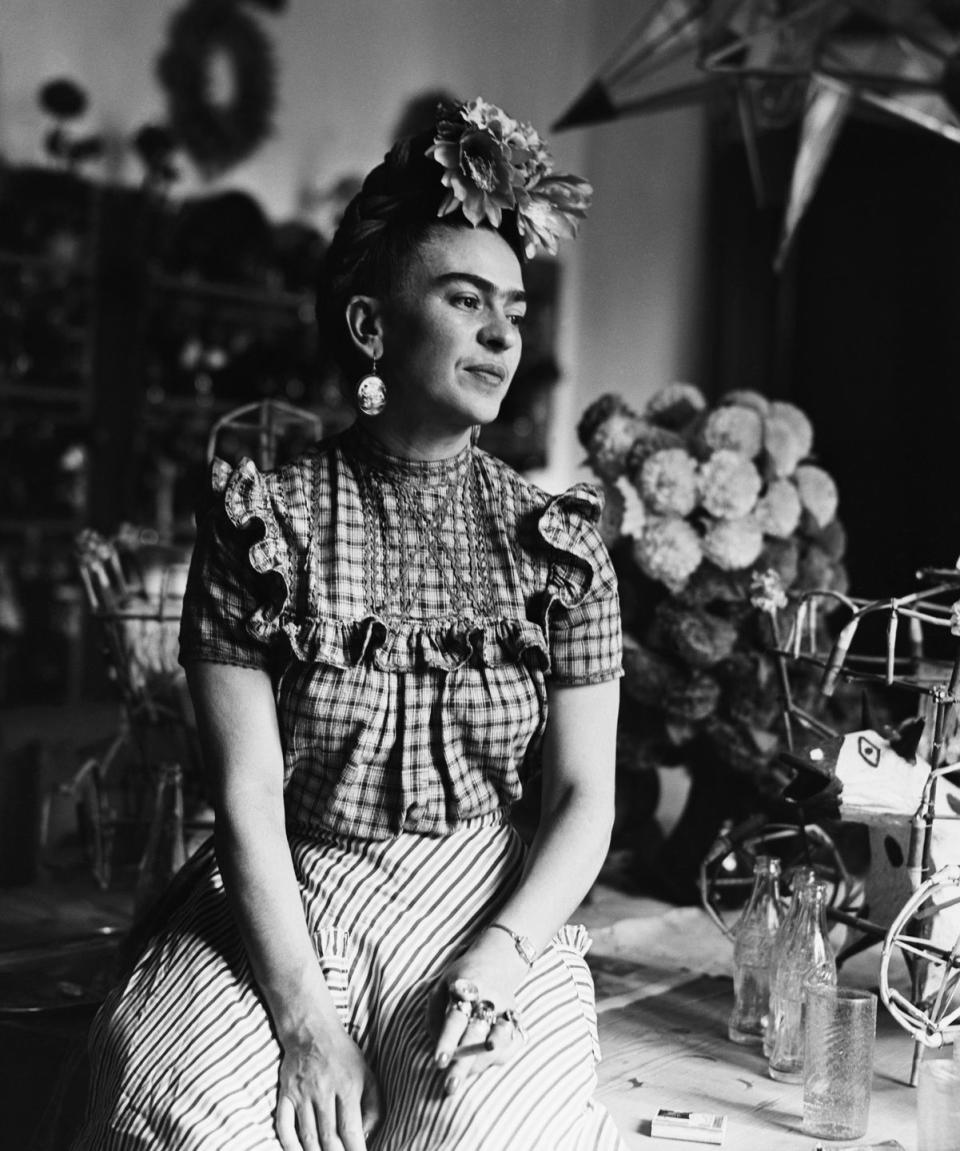
Heartbroken, in a suit
Frida was bold, but it would be hyperbolic, and wrong, to say she was fearless. Like so many women long before her and long after, she was frightened of the unknown. She was hesitant to welcome a child, not knowing what it would do to her marriage. She was scared of losing her man to his own selfish desires—though, for some time, she did. As much physical pain as she felt, she was terrified of going under the knife to treat her body’s injuries. And, while she insisted she painted only what she wanted to and believed in, she was, at times, scared the buyers wouldn’t come in, or that the money wouldn’t be enough.
“Feminism is messy, you know? We’re all dealing with very intimate challenges and gender dynamics.”
Her fears were a subject of shame for Frida, and yet she never kept them in. In 1940, Diego had an affair with Frida’s most beloved sister, Cristina, and Frida divorced him. In a painting titled Self-Portrait With Cropped Hair, she depicted herself looking unamused, sitting on a chair in an oversized dark grey suit and maroon button-up, cutting her long, black hair. Around her, everywhere, are strands of her cropped hair, and above her, the lyrics of a song: Mira que si te quise, fué por el pelo / Ahora que estás pelona, ya no te quiero. (“See, if I loved you, it was for your hair / Now that you’re bald, I don’t love you anymore.”)
“Feminist icon,” we say, recalling Frida today. But this painting and this moment in her life show the deep complexity of feminism. Yes, she was a strong, creative, wildly talented woman with her own ideas and willpower—and yet, a heartbreak at the hands of the man she loved turned her world upside down.
Still, she eventually rose, as all women do.
“Feminism is messy, you know? We’re all dealing with very intimate challenges and gender dynamics,” Gutiérrez says. “Frida wanted to go into this traditional marriage and be the shadow of this big great man while also being herself and being independent.”
“So, for us, it was really important to show that it’s not as simple as: We’re independent feminists. We all have a lot of complexity in the way that we navigate the world and how our gender affects us, and how we sometimes push ourselves down,” the film editor adds. “It’s always complicated.”
After her split from Diego, Frida slicked back her short hair again and rebelled against the feminine dresses he’d adored so much, bringing back her loose suits. Sometimes, when she was feeling celebratory, she would put on a sophisticated western skirt—no typical embroidery in sight—and some chunky earrings.
She never lacked for sexual partners (the film chronicles her many male and female lovers), but the absence of deep romance in her life was evident, and she was no longer catering to the gaze of a man.
It was also at this time that Frida began selling her paintings, traveling the world to exhibit her work, and making a living for herself as an artist, outside of Diego’s shadow.
The artists got back together and remarried just a few months after their divorce, and soon enough, Frida went back to the dresses.
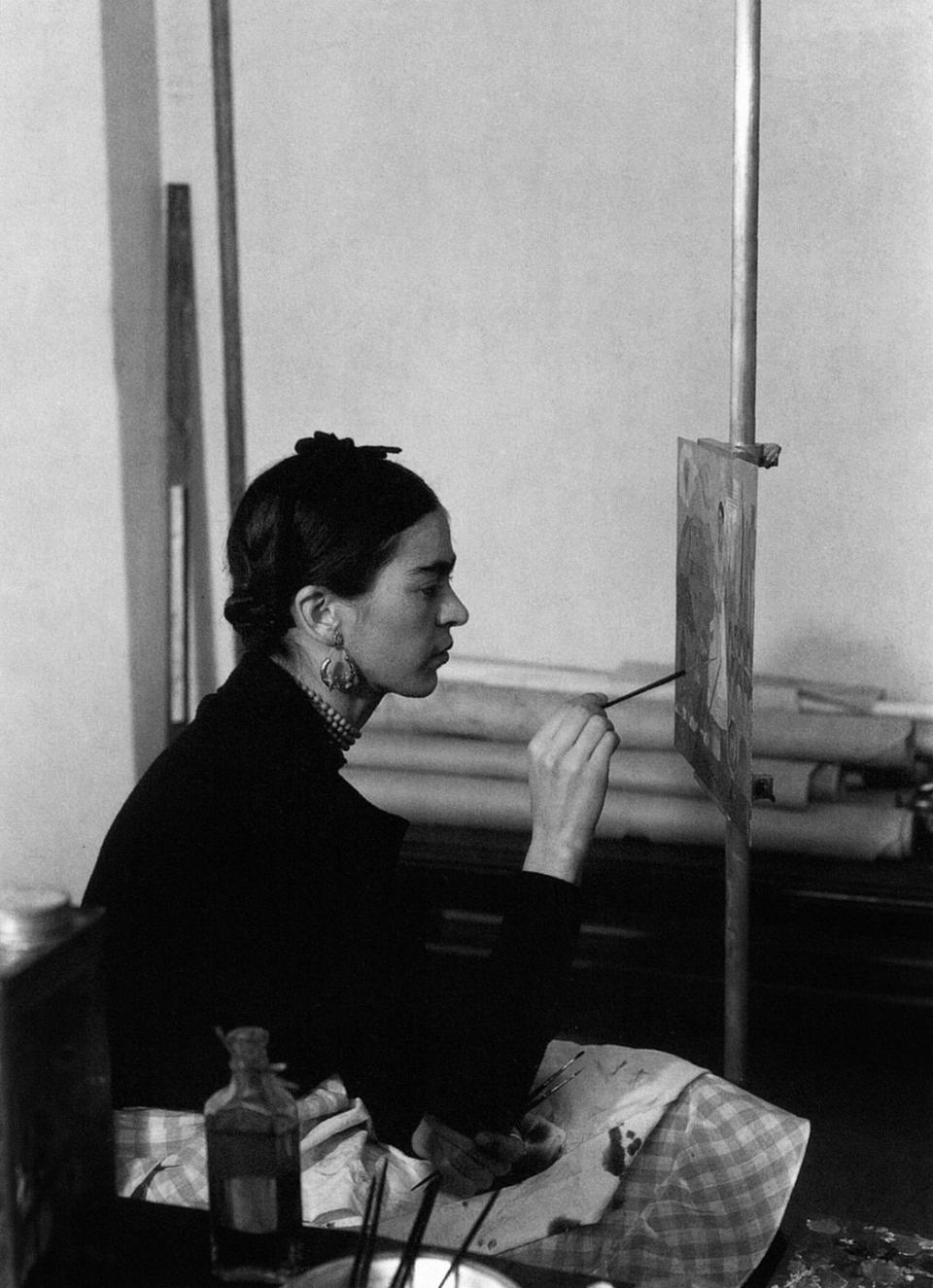
Wearing her pain
Frida spent most of her life in pain. As a young child, she suffered from polio, a disease that left her crippled for the rest of her life. Then, at 18, she was in a terrible bus crash, which left her pelvis punctured and her back forever injured. While married to Diego, she became pregnant and suffered a miscarriage—an experience that broke her. For years, and up until the end of her life, Frida underwent difficult surgeries; at one point, she had to have her right leg amputated due to gangrene. And in her final days, she was mostly bedridden. In her writings, she spoke openly of her suffering, and as she got older, she began to wear it, hand-painting her casts and back braces, and decorating footwear for her prosthetic leg.
“A lot of her art was her facing pain straight on.”
One tall, lace-up boot, on view at the Frida Kahlo Museum in Mexico City, was of bright red leather; it featured a platform heel and was adorned with a hand-painted, fantastical dragonlike creature in green and orange. A dragon, thriving in the burning of its own fire, like Frida herself.
“At first, she was using loose trousers and dresses to cover herself up—her legs, since one was thinner and shorter than the other—but then later on, she was really exposing the disabled body in a very artistic way, from the way that she painted the cast that she was in, to showing her body, underneath all the garments, in her paintings,” Gutiérrez says.
In her 1944 painting The Broken Column, Frida painted herself broken, held up by metal rods in her spine, punctured by nails, and wrapped up in braces and white medical bandages. She is crying, but she is beautiful and naked and looking head-on at the viewer—a stance of defiance and perseverance.
“A lot of her art was her facing pain straight on,” Gutiérrez says. “In her portraits, she is looking straight on and confronting her pain, and putting colour on it and putting flowers on it, and I think that’s how she dealt with a lot of those painful experiences.”
Frida Kahlo’s fashion evolution is the story of a life. She was not four different women with individual personalities and contrasting styles, but exactly one woman, with her intricacies, her pain, her love, and her interlacing layers.
Frida is directed and edited by Carla Gutiérrez (RBG, Julia) and produced by Imagine Documentaries and TIME Studios, in association with Storyville Films. It will be available to stream on 15 March on Prime Video.
You Might Also Like


